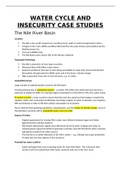WATER CYCLE AND
INSECURITY CASE STUDIES
The Nile River Basin
Location:
The Nile is the world’s largest river and flows from south to north through Eastern Africa
It begins in the rivers (White and Blue Nile) that flow into Lake Victoria and empties into the
Mediterranean Sea
It is over 6,600km long
The Nile Basin covers about 10% of the African continent
Geography/hydrology
The Nile is shared by 10 river basin countries
Measured flow of 84 billion cubic metres
Seasonal variation in flow due to river being susceptible to major inter annual and decadal
fluctuations brought about by ENSO cycles and in the future, climate change
High evaporation losses due to hot arid areas, e.g., in Sudan
Geopolitical issues
Large number of national borders traverse the Nile Basin.
Growing demand due to population growth – currently 300 million live within the basin but this is
expected to double by 2030. For example, Egypt is dependent on the Nile for 95% of its water needs.
Economic scarcity in many countries means that they lack the capital and technology to exploit the
supplies. States such as Rwanda and Ethiopia need large supplies of water to develop crop irrigation,
HEP and industry in order to lift their nations and people out of poverty.
Due to demand from growing populations, development, and the impact of climate change, most of
the Nile Basin countries will be potentially water scarce by 2025.
Impact of history
- Original agreements for sharing Nile’s water were bilateral between Egypt and Sudan
(agreed by their colonial masters).
- Nile Waters Agreements signed away effectively all of the water to Egypt and Sudan as
colonial powers signed on behalf of upstream countries, who felt that all the other countries
had plenty of water from other sources.
- This has led to an unfair allocation of the Nile’s waters – e.g., Ethiopia has major production
of water but very low capture of the resources.
Potential for water conflicts
- Sudan and Egypt have ever increasing needs for more Nile Water. This is because they
receive much less rainfall than other basin countries and rely on the river more.
, - However, a riparian led process of joint decision making called the Nile Basin Initiative
emerged during the 1990s. The NBI has worked with agencies such as the World Bank to
establish a common vision. Despite Egypt and Sudan being involved in the NBI, little has
been achieved.
- Egypt and Sudan are no longer as politically strong and are less well supported by powerful
allies. The neo-colonialism of China is building schemes and dams, particularly in Ethiopia.
- There have been threats of military force between the countries, in particular Egypt has
recently struck a series of military agreements with East African states, signalling its
readiness for more robust engagement in the conflict.
Overall, the emphasis so far has been on cooperation, and therefore it seems unlikely that water
wars will take place here. It is likely that the common vision of the NBI, which seeks to achieve
sustainable socioeconomic development through the equitable usage of, and benefit from, the Nile
Basin resources, and peace, will prevail.
China’s water transfer scheme
What is it?
One of the most ambitious and expensive water transfer projects in the
world, which began in 2003. It involves the construction of 3 canals that
run 1300km across the eastern, middle and western part of China to link
the country’s 4 major rivers: the Yangtze, Yellow, Huai and Hai.
Movement of water from south to north. It will move 45 billion cubic
metres of water a year.
Why is it needed?
- Significant demand for more water for economic growth in the more arid north of China (in
particular Beijing and Tianjin)
- Population density is high, so there is considerable demand for domestic water
- Water deficit (physical scarcity) in the north of the country, and the water table below
Beijing is falling at a rate of 5m a year due to over abstraction (intensive agriculture, demand
from industrial centres)
What are the positive impacts?
Reduction of water insecurity in the north which supports economic development and
improvements in food security and health benefits
Water conservation
Improved irrigation
Pollution treatment
What are the negative impacts?
Resettlement issues as hundreds of thousands displaced due to the construction of dams
and reservoirs (435,000 people displaced)
Ecological damage to the natural environment
Considerable evaporation from canals and reservoirs
Yangtze River is already severely polluted, Yellow River water is undrinkable
Industrial growth along routeways may exacerbate existing pollution problems





